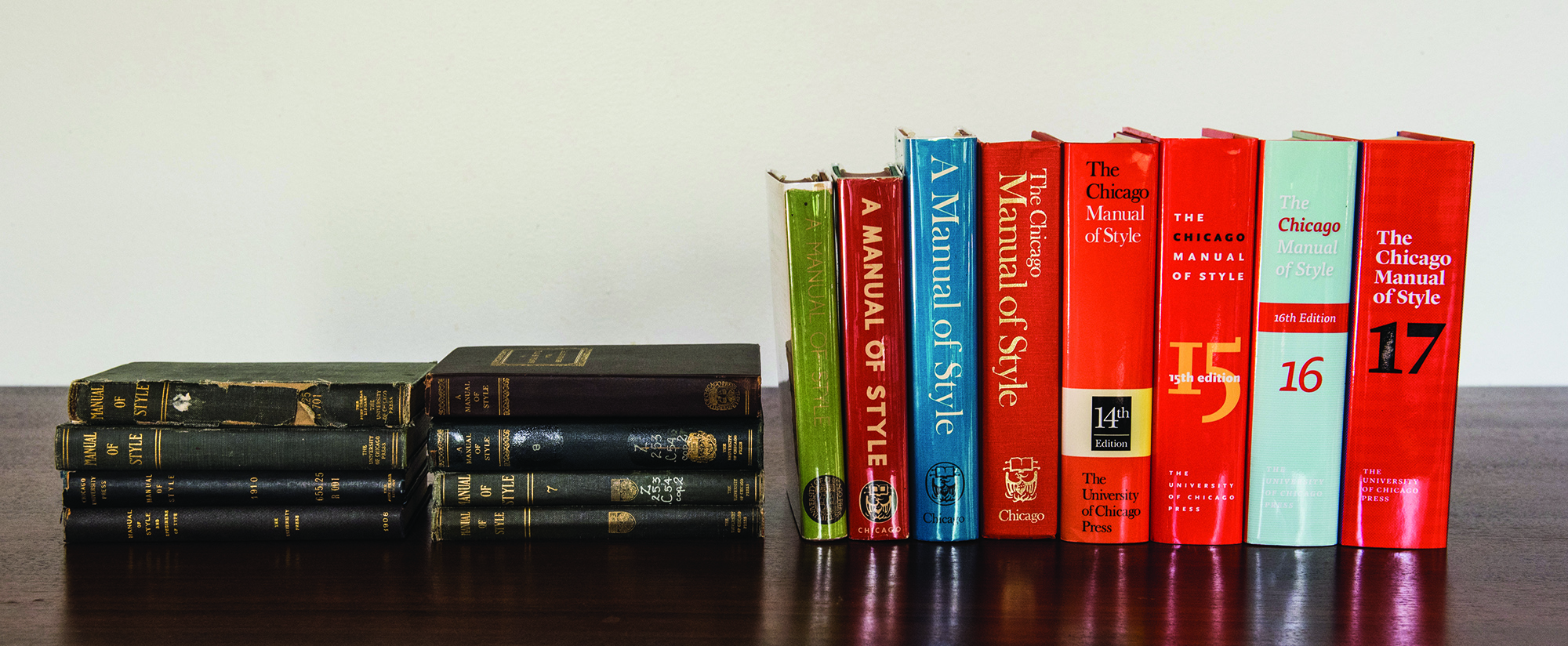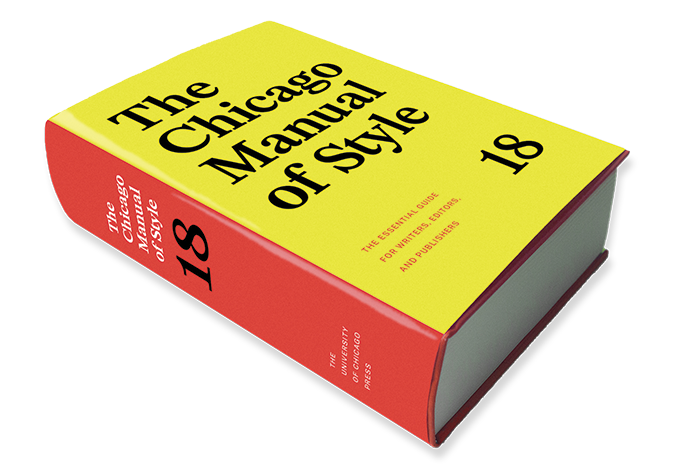
Family portrait: A new edition of The Chicago Manual of Style, released in September, continues a tradition that goes back to the earliest days of the University of Chicago Press. (Photography by Jean Lachat)
The essential guide gets a big update.
The start of style
In the early years of the University of Chicago Press, professors gave their handwritten manuscripts directly to the typesetters, who deciphered the pages and created proofs. Then proofreaders corrected typographical errors and addressed stylistic inconsistencies. These employees gradually compiled a sheet, later a small book, of guidelines to ensure consistency across the press’s publications. The style guide was so foundational to the work of the press that, in 1903, a copy was placed in the cornerstone of the newly constructed press building (today’s University bookstore).
Manual of Style: Being a Compilation of the Typographical Rules in Force at the University of Chicago Press was first published in 1906, bringing the guidelines to external audiences. The first edition was about 100 pages of style guidelines and about 80 pages of sample typefaces. The Manual retained the same structure for the first half of the 20th century.
“When style rules go beyond their role of achieving clarity and consistency, when they become precious or merely doctrinaire, they must be changed or eliminated,” wrote the editors of the 12th edition. Published in 1969, 20 years after its predecessor, this edition was the most significant revision of the century. It contained over 90 percent new material and was restructured to guide readers through the entire publishing process.
Over the years, more changes followed:
- The title The Chicago Manual of Style—which, as the guide grew in prominence, had become its unofficial moniker—was first used in the 13th edition (1982). This version also notably served as “much more a ‘how-to’ book for authors and editors” than previous editions.
- The 15th edition (2003) was the first to grapple with the internet.
- In 2006 The Chicago Manual of Style Online website went live.
- The 16th edition (2010) was the first to have a fully XML-coded manuscript: it was published in print and online simultaneously.
- The 17th edition responded to changes in the media landscape, with guidance for self-publishing, e-books, and social media citations.
- The 18th edition speaks to its historical moment with guidance on inclusive language and how to cite artificial intelligence–generated text and art.—C. C.

Making a new Manual
Creating a new edition of The Chicago Manual of Style never quite stops. The kickoff meeting for the 18th edition was held on February 1, 2021, more than three years before the scheduled release date, but “we’re always working on the next edition in some ways,” says UChicago Press executive editor Mary Laur, who led the revision effort. The CMOS Shop Talk online forum, along with informal questions from readers and suggestions from the press’s authors and editors, allows the revision team to see which topics need clarification or rethinking.
The 18th edition, for instance, includes clearer guidance on the use of the singular they—“unquestionably the most anticipated and requested change in the new edition,” Laur says. Some changes, while likely to go unnoticed among many readers, are the source of much celebration among copy editors: The first word of a grammatically complete sentence following a colon will now get an initial capital. A change Laur has long supported—omitting place of publication in book citations—finally got its day too.
The revision process itself has undergone revision. When Laur started at the press in 1998, updating the manuscript involved cutting pages out of a print copy of the Manual with an X-Acto knife. Today, the revision team circulates a Word document with proposed changes to its internal and external advisory boards, a process that comes with its own challenges, Laur says: “There were so many comments that we couldn’t even combine them into a single document.”
To top off the 18th edition—“the most significant revision we’ve done in a generation”—the press chose a bright yellow cover that departs from the reds, oranges, and blues of years past. (The typeface on the cover was custom-made by the press’s principal designer Isaac Tobin; he named it “Seamoss” to mirror the press’s pronunciation of the acronym “CMOS.”)
Sending a new edition of CMOS out into the world always comes with some anxiety. “We’ve put all this work into it … and hopefully people will think we made good decisions,” Laur says. And fortunately, nothing is written in stone: “We already have a folder for the 19th edition.”—S. A.
Test your CMOS skills
CMOS or no más: Do the following sentences follow the 18th edition of The Chicago Manual of Style? (Answers below.)
- Meet me at the entrance to Ida Noyes, or go downstairs and grab a table in the Pub.
- William finished Autumn Quarter with three A’s, two B’s, and one C.
- When the school’s then-principal retired, the then–assistant principal was promoted.
- Children of Baby Boomers, or the me generation, are often Millennials.
- Daylight saving time ends on the first Sunday in November, at which point Chicago will go back to Central Standard Time and wake up to lighter mornings.
- 1906 was the year the University of Chicago Press style sheet turned into the first edition of the Manual of Style, now in its 18th edition.
- About 45 percent of the UChicago Magazine staff have dogs, while less than 37 percent have cats; however, the cats outnumber the dogs by about two to one.—R. L. S.
Answers
- No, see section 6.25. Two imperative sentences joined by a coordinating conjunction are now preferably interpreted as a single clause with a compound predicate rather than as two independent clauses, so no comma is needed before the conjunction.
- Yes, see sections 7.15, 7.68. The plural form of a capital letter denoting a scholastic grade now takes an apostrophe.
- Yes, see section 7.96. To prevent misreading, when using then to mean former insert a hyphen or, when preceding an open compound, an en dash.
- No, see section 8.43. Terms for generations that include the word generation are capitalized (e.g., Me Generation, Silent Generation, Generation X). Terms like baby boomers and millennials are lowercase.
- Yes, see section 8.91. While daylight saving time has stayed lowercase, official time zones are now capitalized (e.g., Central Standard Time, Eastern Daylight Time).
- Yes, see sections 9.5, 9.31. The 18th edition allows for years expressed as numerals to begin a sentence “if necessary.” It’s still preferable to reword to avoid beginning the sentence with a number, but you now have options! Sentences may also begin with numeric terms such as 401(k) and 3D.
- Yes, see section 9.20. Less rather than fewer may now be used with percentages.
Updated 11.12.2024 to correct question number 5. The end of daylight savings time in November brings us lighter mornings.
